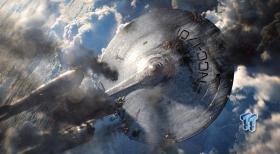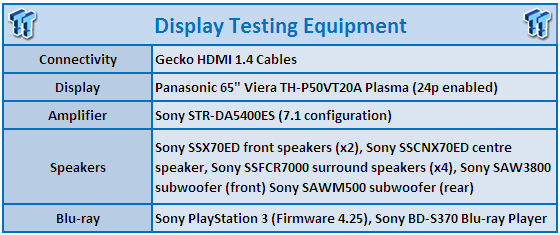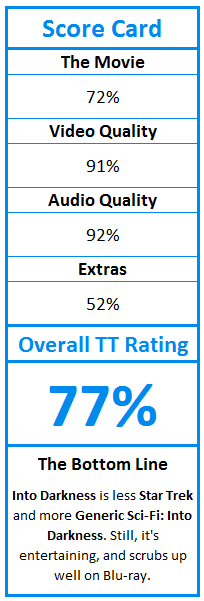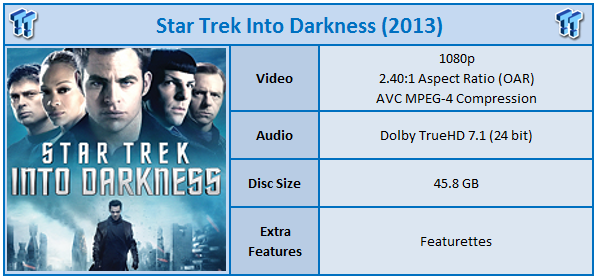
In 1990, the year before his death, Star Trek creator Gene Roddenberry told the L.A. Times "there's a good chance that when I'm gone, others will come along and do so well that people will say, 'Oh, that Roddenberry. He was never this good." Casual audiences might agree, but for the many lifelong Star Trek fans, J.J. Abram's franchise revival opened an interesting aside for a franchise fast approaching 50 years of age, but hardly represents a return to form for the core Star Trek ethos; its philosophical ideals and the promise of a brighter future - in direct contravention of a film entitled Into Darkness.
Three years on from 2009's franchise reboot, whose plot created an alternate timeline allowing the film to take certain liberties with established canon and morph into its own version of Trek, J.J. and company return with Into Darkness.
Following a suicide blast at Starfleet HQ and subsequent aerial attack resulting in the murder of Starfleet commanders masterminded by turncoat Starfleet agent John Harrison (Benedict Cumberpatch), the Enterprise crew headed by Captain James T. Kirk (Chris Pine) are re-commissioned to mount a mission to kill Harrison on Kronos, the Klingon home world. Kirk refuses to accept orders at face value and decides to take Harrison hostage. After a brief battle, Harrison unexpectedly gives himself up, willingly boarding the Enterprise as a prisoner. Unfortunately, it's quickly revealed that neither the mission, nor Harrison are quite as expected, when the crew of the Enterprise finds itself in the middle of a much larger plot and grave danger.
For the uninitiated, Star Trek circa 2013 is an entertaining science fiction adventure, which commands viewers' attention right from the opening scenes. But saddling itself with the name Star Trek automatically attaches 50 years of baggage, and that does this film no favors. The truth is, this modern incarnation of the franchise has little in common with it older siblings. Star Trek has always gladly worn its heart on its sleeve with the epitaph of 'thinking man's sci-fi', but ruminating about the plot only reveals the numerous holes that riddle the script, not least the mind messing alternate timeline, which try as I might to explain to my non-fan girlfriend, really struggled to do.
In true J.J. Abrams fashion, there's a few surprises, but perhaps the worst kept is that of the true identity of the mysterious John Harrison - he's Khan Noonien Singh from both the Original Series episode 'Space Seed' and the feature film The Wrath of Khan. But Khan was never an Englishman, nor does Benedict Cumberpatch even remotely resemble Ricardo Montalban. Try explaining that to newcomers - and that's the whole problem with the film. It tries to be all things to all people and it just doesn't make a lick of sense. Why try and shoehorn Trek lore into a film and then not even attempt to make it cohesive? For every cameo by a tribble or inflection of a classic phrase, we have another franchise contradiction or out of character motivation.
Having been tapped to direct Star Wars Episode VII for LucasFilm, it seems that J.J. Abrams will now slink off from the franchise that he's revealed he was never a fan of, leaving the gates open for someone else to take the reins. I can only hope that that person will stay true to the core ethos of Star Trek, rather than continue to churn out what amounts to, admittedly entertaining, but otherwise generic science fiction action, trading on the basis of Star Trek's branding.
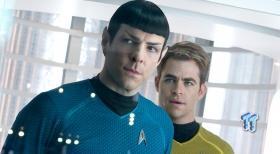
Video
Star Trek Into Darkness is presented in the original aspect ratio of 2.40:1, encoded with AVC MPEG-4 compression. Note that some scenes were originally filmed with IMAX cameras in a 1.43:1 aspect ratio, those of which are cropped on this Blu-ray.
Filmed with a variety of camera and lens systems and finished in a 2K digital intermediate, Star Trek Into Darkness looks as fantastic as one would rightly assume, even if you have to occasionally wince over the hugely excessive lens flare that Abrams so adores.
Resembling a Mac store in space, the production design is as sumptuous as ILM's visual effects are impressive and this translates very well to the small screen. Occasionally, some images are a little soft, but as this mirrors the theatrical experience, I'm convinced it's intentional. Otherwise the image is very crisp and detailed, and certainly a sight to behold. It's a bit disappointing that we don't get the mattes opened with an increase to the vertical resolution from IMAX scenes, but perhaps we might get this later down the track.
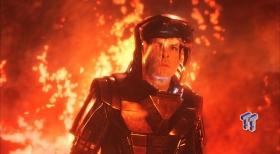
Audio
Star Trek Into Darkness is presented in Dolby TrueHD 7.1 at 24 bits.
A far cry from the more dated entries in the Star Trek feature film canon, Into Darkness utilizes all the tricks of modern sound mixing, making for one hell of an impressive surround sound experience.
It's certainly easier to pin point the deficiencies in the track, compared to what it does right. But even so, I'm rather struck for complaints. This is an incredibly effective and encompassing track, which from the opening chords of Michael Giacchino's bombastic updated theme song alludes to. Bass performance is tight and strong and resonates where appropriate.
As is the norm with TrueHD tracks, audio here is mastered at a lower level than DTS HD-MA tracks, which may require a minor volume adjustment.
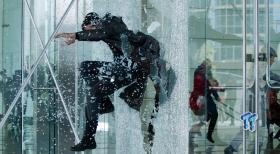
Extras
Star Trek Into Darkness comes to Blu-ray with more than a hint of controversy - in short, production company Bad Robot produced a bunch of extra features and then shopped them around to specific U.S. retailers as exclusives, making obtaining the definitive collection of extra features nigh impossible. Worse, Australia doesn't even have the chance to participate and thus totally misses out. In a global market, this just doesn't cut it. Bad Robot. Very Bad Robot. Still, let's take a look at what is here.
The package is made entirely up of Eight Featurettes, which retain a standard style and editing structure which run approximately 41 minutes in length. Highlights include the Creating the Red Planet short, debatably the best on the set, which runs through the initial concepts and make up designs, which went into to making the film's opening a memorable one.
Attack On Starfleet is concerned with the visual effects and live action stunts of Khan's air attack sequence, while The Enemy of My Enemy had me throwing things at the screen whilst watching the filmmakers justify the inclusion of the Original Series villain.
Sadly missing are any Theatrical Trailers, which I understand are present on one of the U.S. exclusive Blu-ray sets.
